Say you wish to build a picket fence around your home. Upon assembling this picket fence, you suggest that it should be built 6 feet away from the boundary encircling your home. Below is a rough plan of this layout.
 Example 1, Aishah Amri - StudySmarter Originals
Example 1, Aishah Amri - StudySmarter Originals
This is an example of a locus. Notice how you have planned to construct a picket fence surrounding your home precisely 6 feet away from the perimeter of your home. This is the standard measure you wish to accomplish about this boundary.
The locus
To begin this topic, let us first establish the definition of a locus.
A locus is a set of points that satisfy a specific condition. The plural term for a locus is called the loci.
In two dimensions, a locus of points can either be represented by a curve or a line. Before we get into the details of the types of loci and their construction, let us also define the following term.
Let A be a point and B be a set of objects. If A is of equal distances from B, then A is said to be equidistant from B.
Types of loci and their construction
In this section, we shall look at four common types of loci. These are listed below.
The circle (locus about a point).
The sausage shape (locus about a line segment).
Perpendicular bisector.
Angle bisector.
Here, we will focus on two elements for each locus mentioned above. First, we shall identify their characteristics, and second, we shall learn how to construct them step-by-step.
The Circle
The circle is a locus of points that are equidistant from a fixed point, called the centre.
The fixed distance from the centre to each point in the set is called the radius. Below is a graphical representation of this definition.
 Graphical representation of a circle, Aishah Amri - StudySmarter Originals
Graphical representation of a circle, Aishah Amri - StudySmarter Originals
Construction
To construct this locus about a point, or a circle, you will need a compass, pencil and ruler. In order to draw this shape, you will also require the length of the radius.
Step 1: Open your compass to the distance of the radius.

Step 2: Place the point of the compass in the centre.
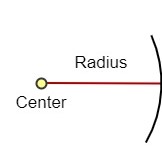
Step 3: Draw an arc around the centre until the two ends meet.

Let us look at an example that applies this technique.
Given a point, A, construct the locus of all points that is 2cm from A.
Solution
Note that the radius here is 2cm. Following the steps above, we find that the locus of points that are exactly 2cm away from point A should look like the diagram below.
 Example 2, Aishah Amri - StudySmarter Originals
Example 2, Aishah Amri - StudySmarter Originals
The sausage shape
A locus of points equidistant from a line segment creates a sausage shape. We can think of this type of locus as a track surrounding a line segment.
Below is a graphical representation of this definition.
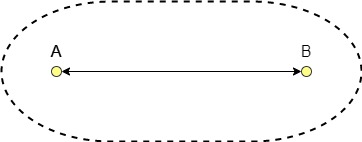
Graphical representation of a sausage shape, Aishah Amri - StudySmarter Originals
Construction
To construct this locus of a line segment, or a sausage shape, you will need a compass, pencil and ruler.
Step 1: Given a line segment of length x units, mark the two endpoints as A and B.

Step 2: Open your compass based on the required measure given to form this locus. Draw an arc from each endpoint A and B. Ensure that this marking forms a curve (as shown below) that is clearly visible.

Step 3: Draw several arcs (as shown below) from any point along the line segment with this given locus measure. You need to do this for both the top and bottom portions of the line segment.

Step 4: Use your ruler to join the uppermost point of each of your arcs.

Step 5: Upon tidying up your locus, you will see that this forms a sausage-like structure.

Let us look at an example that involves this technique.
Draw a line, AB, that is 6cm in length. Construct the locus of all points that are 3cm from AB.
Solution
We shall begin by forming the 6cm line AB. Now following the steps above, we find that the locus of points that are exactly 3cm away from AB should look like the sketch below. Remember to keep your compass open at 3cm at all times when you construct this locus.
 Example 3, Aishah Amri - StudySmarter Originals
Example 3, Aishah Amri - StudySmarter Originals
The perpendicular bisector
The perpendicular bisector is a locus of points that are equidistant from two fixed points. A perpendicular bisector divides the line segment formed by those two fixed points into two equal smaller line segments, as the word bisector suggests.
The diagram below provides an illustration of a perpendicular bisector.
 Graphical representation of a perpendicular bisector, Aishah Amri - StudySmarter Originals
Graphical representation of a perpendicular bisector, Aishah Amri - StudySmarter Originals
The two fixed points are represented by X and Y. The line OM is the perpendicular bisector of the line segment XY. The points A, B, C and M lie on the perpendicular bisector and are equidistant from both X and Y. Thus, XM = YM, XA = YA, XB = YB and XC = YC. Furthermore, OM is perpendicular to XY.
Construction
To construct a perpendicular bisector, you will also need a compass, pencil and ruler.
Step 1: Given two points A and B, draw a line segment that joins these points.

Step 2: Open your compass to more than half of the line segment AB. Taking A as the centre, draw arcs above and below the line segment.

Step 3: Repeat Step 2, this time taking B as the centre. Label the points of intersection as X and Y. Here, AX = BX and AY = BY.
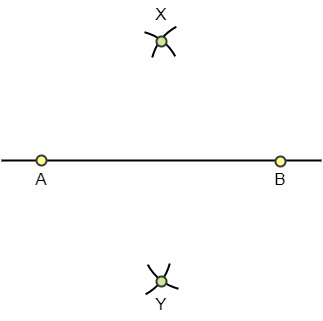
Step 4: Connect the points X and Y. The line XY is the perpendicular bisector of AB.

Below is an example that involves this technique.
Given the rectangle, ABCD, below, draw a line that cuts the side CD into two equal halves.
 Example 4 (1), Aishah Amri - StudySmarter Originals
Example 4 (1), Aishah Amri - StudySmarter Originals
Solution
We are told to cut the side CD into two equal halves. This suggests that we need to find the perpendicular bisector of the line CD. Following the steps above, we find that the perpendicular bisector of CD splits this side (measuring 7 cm) into two equal lengths of measures 3.5 cm each.
 Example 4 (2), Aishah Amri - StudySmarter Originals
Example 4 (2), Aishah Amri - StudySmarter Originals
The angle bisector
The angle bisector is the locus of points that are equidistant from the sides of the angle. As before, the term bisector means dividing an object into two equal parts. Thus, the angle bisector results in a line that divides an angle into two equal parts.
The illustration below gives us a better understanding of the angle bisector.
 Graphical representation of an angle bisector, Aishah Amri - StudySmarter Originals
Graphical representation of an angle bisector, Aishah Amri - StudySmarter Originals
The two fixed lines are represented by the line segments AC and BC. The line CD is the angle bisector. The angle bisector bisects Angle C into two equal measures, namely, Angle ACD and Angle BCD. Point D is equidistant from both lines AC and BC. Thus, AD = BD. Additionally, AD is perpendicular to AC and BD is perpendicular to BC.
Construction
To construct an angle bisector, you will need a compass, pencil and ruler.
Step 1: Given two lines OA and OB, take O as the centre and draw two arcs such that it cuts OA and OB at points X and Y respectively. The span of the compass should be less than the distance from OA and OB. Here, OX = OY.
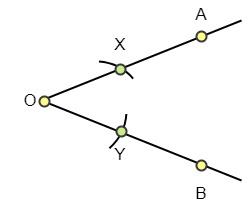
Step 2: Without adjusting the distance between the legs of the compass, construct two arcs with X and Y as centres so that these two arcs intersect at a point P. Here, XP = YP.
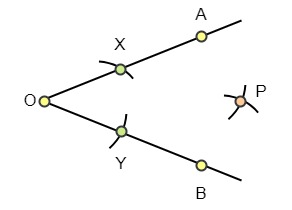
Step 3: Connect the points OP. The line OP is the angle bisector of Angle O. Here, AP = BP and the Angle O is bisected into two equal measures: Angle AOP and Angle BOP.
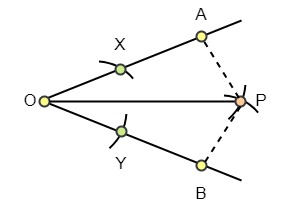
Below is an example that applies this technique.
Given the equilateral triangle, ABC, below, construct the angle bisector for each vertex and identify the point at which all three angle bisectors intersect.
 Example 5 (1), Aishah Amri - StudySmarter Originals
Example 5 (1), Aishah Amri - StudySmarter Originals
Solution
In this case, we need to construct the angle bisector for each vertex and extend the line so that we can observe where these lines intersect inside the triangle. Applying the steps above for each corner of this triangle, we find that the point at which all three angle bisectors intersect inside the triangle should look like the sketch below. This point is denoted by P.
 Example 5(2), Aishah Amri - StudySmarter Originals
Example 5(2), Aishah Amri - StudySmarter Originals
Note: The angle of each vertex for an equilateral triangle is 60o. Thus, constructing an angle bisector will split this angle into two equal angles measuring 30o each.
Real-world example
We shall end this topic with a real-world problem involving the construction of loci.
A boat rows away so that it is always the same distance from a port P and a lighthouse L. The port and the lighthouse are 4 km apart. Draw a scale diagram showing the distance between the port and the lighthouse. Then, construct a possible path of this boat in the diagram. Use the scale 1 km: 1 cm.
We shall first draw the line segment PL. This represents the distance between the port and the lighthouse.
 Example 6 (1), Aishah Amri - StudySmarter Originals
Example 6 (1), Aishah Amri - StudySmarter Originals
To construct a possible path for the boat, we need to create a perpendicular bisector between the port and the lighthouse. This is shown below.
 Example 6 (2), Aishah Amri - StudySmarter Originals
Example 6 (2), Aishah Amri - StudySmarter Originals
The point at which the two arcs intersect is one point at which the boat is of equal distance from the port and the lighthouse. We shall call this point R. Join point P to point R. Do the same for points L and R. The course of the boat will follow a triangular path from the port to this point and to the lighthouse. This is indicated by the red arrows. This is sketched in the diagram below.
Notice that any point on the perpendicular bisector gives you a possible path for the boat since by definition any point in that perpendicular bisector is equidistant to points P and R.
 Example 6 (3), Aishah Amri - StudySmarter Originals
Example 6 (3), Aishah Amri - StudySmarter Originals
Construction and Loci - Key takeaways
A locus is a set of points that follow a distinct rule and is described by a curve or a line.
To construct any locus, you will need a pencil, ruler and compass.
- Types of Loci
| Name of Loci | Description |
| The Circle | Locus of points that are equidistant from a point |
| The Sausage Shape | Locus of points that are equidistant from a line segment |
| Perpendicular Bisector | Locus of points that are equidistant from two points |
| Angle Bisector | Locus of points that are equidistant from two lines |




































